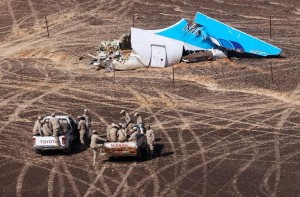Analysis
Though many mysteries still surround the recent crash of a Russian airliner over the Sinai Peninsula, some explanations of what happened are more likely to be true than others. On Oct. 31, Metrojet Flight 9268 broke into pieces shortly after reaching a cruising altitude of 9,500 meters (31,000 feet), killing all 224 passengers and crew members onboard. Stratfor, along with the rest of the world, is waiting for additional details to emerge from the aircraft’s flight data and cockpit voice recorders.
Though we cannot fully rule out the possibility of a catastrophic structural failure, such an explanation would be unusual given the circumstances of the crash. Most aircraft accidents that involve a structural failure occur amid the physical stress of takeoff and landing; it is uncommon for aircraft to break apart at cruising altitude.

- 01 Nov 2015, Egypt — EGYPT. NOVEMBER 1, 2015. Wreckage at the site where a Russian aircraft crashed in Egypt’s Sinai Peninsula near El Arish city. Kogalymavia Airbus A321 came down in central Sinai as it traveled from Sharm el-Sheikh to St Petersburg, killing all 217 passengers and 7 crew members on board. Maxim Grigoryev/TASS — Image by © Maxim Grigoryev/ITAR-TASS Photo/Corbis
It is also unlikely that jihadists in Sinai shot down the aircraft with a man-portable air defense system, or MANPAD. Although militants in the area have managed to use a MANPAD to shoot down an Egyptian helicopter and have fired missiles at Israeli aircraft, Flight 9268 would have been well out of range of these weapons. In addition, according to an initial review of the flight data recorder, the aircraft was not struck by an object from outside the plane.
Finally, the crash probably was not caused by an electrical failure. Under such circumstances, the aircraft’s pilots likely would have been able to maneuver the plane so that it glided to the ground without any sort of catastrophic consequences.
The More Likely Explanation
Given the unlikelihood of the alternative scenarios, it seems that the most probable explanation for the downed plane is the existence of an explosive device onboard.
Jihadists have long fixated on the idea of attacking passenger aircraft with bombs. Aircraft make attractive targets not only because they are fragile, which makes it possible to cause damage with a relatively small amount of explosives, but also because previous attacks against them have generated a massive amount of media attention that has magnified the amount of terror felt among the population. Chechen suicide bombers have taken down Russian aircraft before, and al Qaeda has nearly managed to do the same in several instances, such as the 2001 shoe bombing plot, the 2006 liquid bombing plot and the 2009 underwear bombing plot.
Jihadists have also used a number of fairly sophisticated explosive devices in Egypt in recent months, so the creation and deployment of a small but effective improvised explosive device would fall within the capabilities of the al Qaeda or Islamic State groups active in the country. Flight 9268 took off from Egypt’s Sharm el-Sheikh airport, whose state of security is known to be particularly poor. The airport’s security agents frequently offer to accept bribes in exchange for allowing passengers to bypass security screening checkpoints, and its cargo security screenings are not nearly as stringent as those conducted in the United States or Europe. While certain airlines, especially European and Israeli carriers, often require additional security checks because of heightened threats to civilian aviation, Russian carriers typically do not follow suit by requesting additional screening procedures.
Combined with the fact that it is quite easy to smuggle explosives onto an aircraft, the airport’s lax security increases the likelihood that an explosive device detonated onboard Flight 9268. The device could have been carried by a person on the flight or loaded into the cargo hold. Stratfor will be watching carefully for any claims of responsibility that might shed more light on the perpetrators and their motives, but so far no credible claims have been made. (The Islamic State’s Wilayat Sinai released a statement asserting its responsibility for the attack, and several Islamic State supporters released a bogus video on social media, but no credible evidence to support the group’s claim has emerged.)
The reality of airline security is that with enough persistence and innovation, an attacker will inevitably get a device through any security system. And the next device might function better than the shoe and underwear bombs — two attempts in which disaster was only narrowly averted. If a bomb did indeed bring down Flight 9268, the public must maintain a realistic expectation of aviation security efforts and fight the understandable impulse to ascribe superhuman abilities to the attackers or make unrealistic demands of passenger screeners. The costs of such demands are enormous, and they will never be able to fully guarantee passengers’ security. The world is a dangerous place; there will always be people who wish to do terrible things to other human beings, and occasionally, they will succeed.
Update: According to CNN, no explosive residue has been located on the wreckage so far. The new information, if true, increases the probability that the aircraft suffered a catastrophic structural failure. However, the existence of explosive residue on other pieces of the scattered wreckage has not yet been ruled out.








